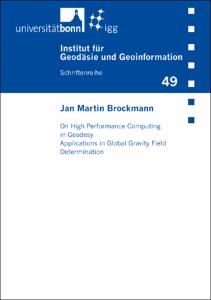Brockmann, Jan Martin: On high performance computing in geodesy : applications in global gravity field determination. - Bonn, 2015. - , . In: Schriftenreihe / Institut für Geodäsie und Geoinformation, 49.
Online-Ausgabe in bonndoc: https://hdl.handle.net/20.500.11811/1634
Online-Ausgabe in bonndoc: https://hdl.handle.net/20.500.11811/1634
@phdthesis{handle:20.500.11811/1634,
author = {{Jan Martin Brockmann}},
title = {On high performance computing in geodesy : applications in global gravity field determination},
school = {},
year = 2015,
series = {Schriftenreihe / Institut für Geodäsie und Geoinformation},
volume = 49,
note = {Autonomously working sensor platforms deliver an increasing amount of precise data sets, which are often usable in geodetic applications. Due to the volume and quality, models determined from the data can be parameterized more complex and in more detail. To derive model parameters from these observations, the solution of a high dimensional inverse data fitting problem is often required. To solve such high dimensional adjustment problems, this thesis proposes a systematical, end-to-end use of a massive parallel implementation of the geodetic data analysis, using standard concepts of massive parallel high performance computing. It is shown how these concepts can be integrated into a typical geodetic problem, which requires the solution of a high dimensional adjustment problem. Due to the proposed parallel use of the computing and memory resources of a compute cluster it is shown, how general Gauss-Markoff models become solvable, which were only solvable by means of computationally motivated simplifications and approximations before. A basic, easy-to-use framework is developed, which is able to perform all relevant operations needed to solve a typical geodetic least squares adjustment problem. It provides the interface to the standard concepts and libraries used. Examples, including different characteristics of the adjustment problem, show how the framework is used and can be adapted for specific applications. In a computational sense rigorous solutions become possible for hundreds of thousands to millions of unknown parameters, which have to be estimated from a huge number of observations. Three special problems with different characteristics, as they arise in global gravity field recovery, are chosen and massive parallel implementations of the solution processes are derived. The first application covers global gravity field determination from real data as collected by the GOCE satellite mission (comprising 440 million highly correlated observations, 80,000 parameters). Within the second application high dimensional global gravity field models are estimated from the combination of complementary data sets via the assembly and solution of full normal equations (scenarios with 520,000 parameters, 2 TB normal equations). The third application solves a comparable problem, but uses an iterative least squares solver, allowing for a parameter space of even higher dimension (now considering scenarios with two million parameters). This thesis forms the basis for a flexible massive parallel software package, which is extendable according to further current and future research topics studied in the department. Within this thesis, the main focus lies on the computational aspects.},
url = {https://hdl.handle.net/20.500.11811/1634}
}
author = {{Jan Martin Brockmann}},
title = {On high performance computing in geodesy : applications in global gravity field determination},
school = {},
year = 2015,
series = {Schriftenreihe / Institut für Geodäsie und Geoinformation},
volume = 49,
note = {Autonomously working sensor platforms deliver an increasing amount of precise data sets, which are often usable in geodetic applications. Due to the volume and quality, models determined from the data can be parameterized more complex and in more detail. To derive model parameters from these observations, the solution of a high dimensional inverse data fitting problem is often required. To solve such high dimensional adjustment problems, this thesis proposes a systematical, end-to-end use of a massive parallel implementation of the geodetic data analysis, using standard concepts of massive parallel high performance computing. It is shown how these concepts can be integrated into a typical geodetic problem, which requires the solution of a high dimensional adjustment problem. Due to the proposed parallel use of the computing and memory resources of a compute cluster it is shown, how general Gauss-Markoff models become solvable, which were only solvable by means of computationally motivated simplifications and approximations before. A basic, easy-to-use framework is developed, which is able to perform all relevant operations needed to solve a typical geodetic least squares adjustment problem. It provides the interface to the standard concepts and libraries used. Examples, including different characteristics of the adjustment problem, show how the framework is used and can be adapted for specific applications. In a computational sense rigorous solutions become possible for hundreds of thousands to millions of unknown parameters, which have to be estimated from a huge number of observations. Three special problems with different characteristics, as they arise in global gravity field recovery, are chosen and massive parallel implementations of the solution processes are derived. The first application covers global gravity field determination from real data as collected by the GOCE satellite mission (comprising 440 million highly correlated observations, 80,000 parameters). Within the second application high dimensional global gravity field models are estimated from the combination of complementary data sets via the assembly and solution of full normal equations (scenarios with 520,000 parameters, 2 TB normal equations). The third application solves a comparable problem, but uses an iterative least squares solver, allowing for a parameter space of even higher dimension (now considering scenarios with two million parameters). This thesis forms the basis for a flexible massive parallel software package, which is extendable according to further current and future research topics studied in the department. Within this thesis, the main focus lies on the computational aspects.},
url = {https://hdl.handle.net/20.500.11811/1634}
}






